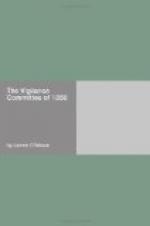One of the Executive Committee had served his term
of two years in the Ohio State Prison for forgery;
here in San Francisco he had, during two city elections,
been the trusted agent and disburser of a very heavy
sack in the honest endeavor to secure the nomination,
and promote the election, of his principal to high
office, yet this pure man was honored by his associates
of the Committee, and became singularly active in pressing
the expatriation of some of the very “ruffians
and ballot-box-stuffers” he had patronized and
paid. He had learned that “dead men told
no tales.” This pure-character did not
stand alone in his experience of penal servitude,
as birds of a feather, and he was under no necessity
of examplifying Lord Dundreary’s bird, to go
into a corner and flock by himself. That some
turbulent offenders, and largely too many of them,
defied the law, is likewise true. But that they
were countenanced or favored by the Judges, is utterly
without truthful foundation. And it is remarkable
that, of all the men hanged or expatriated by the Committee,
only two had ever been complained of or arraigned before
the Courts for any crime of violence; not one of them
all had been here accused or suspected of theft or
robbery, or other felony. This is more, as I have
just above stated, than can be said of some of the
forty-one members of the Executive Committee.
And among the members of the rank and file of the
five thousand or six thousand enrolled upon the lists
of the Committee — of natives and English-speaking
citizens or residents — there were scores of
scoundrels of every degree, bogus gold-dust operators,
swindlers and fugitives from justice. Of the members
of other nationalities — some of whom had not
been in the country long enough to acquire English
— I have no occasion to pass remark; but the
fear of communism and disturbance, from the increase
of its incendiary votaries in our country, east and
here, cannot be lessened or composed by the recollection
of the conduct of many of the same nationalities who
then swelled the ranks of the Committee troops.
Chapter II.
Saturday Nov. 19, 1855, between 5 and 6 o’clock,
the community was startled by the report that General
Richardson, United States Marshal, had been shot dead
by a gambler. The shooting occurred on the south
side of Clay street, about midway between Montgomery
and Leidesdorff streets. The fatal shot was fired
from a deringer pistol by Charles Cora. Cora
was a gambler, yet he did not look the character.
He was a low-sized, well-formed man; dressed in genteel
manner, without display of jewelry or loudness; was
reserved and quiet in his demeanor; and his manners
and conversation were those of a refined gentleman.
I first saw him at the Blue Wing, a popular rendezvous
for politicians, on Montgomery street, east side,
between Clay and Commercial streets, and my impression
then was that he was a lawyer or a well-to-do merchant.




